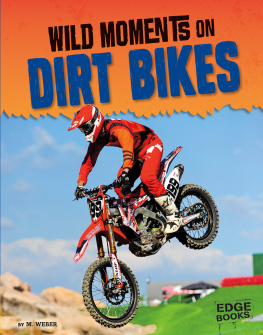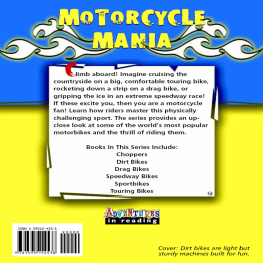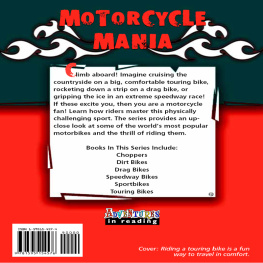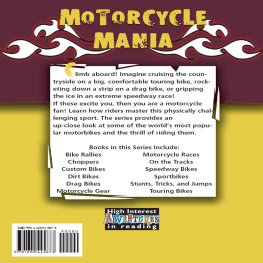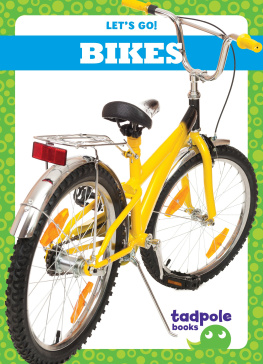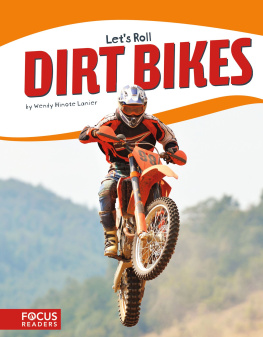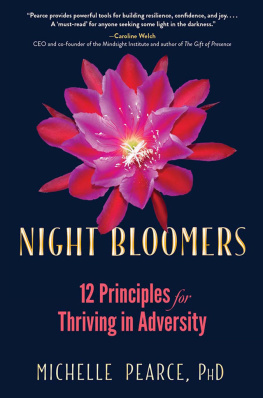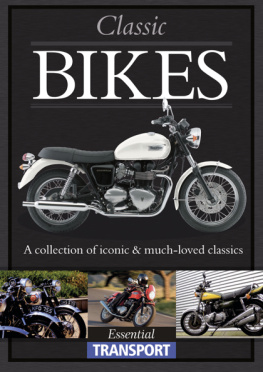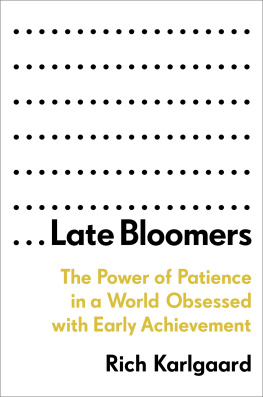Jungnickel - Bikes and Bloomers
Here you can read online Jungnickel - Bikes and Bloomers full text of the book (entire story) in english for free. Download pdf and epub, get meaning, cover and reviews about this ebook. City: London, publisher: Goldsmiths, University, genre: Home and family. Description of the work, (preface) as well as reviews are available. Best literature library LitArk.com created for fans of good reading and offers a wide selection of genres:
Romance novel
Science fiction
Adventure
Detective
Science
History
Home and family
Prose
Art
Politics
Computer
Non-fiction
Religion
Business
Children
Humor
Choose a favorite category and find really read worthwhile books. Enjoy immersion in the world of imagination, feel the emotions of the characters or learn something new for yourself, make an fascinating discovery.

- Book:Bikes and Bloomers
- Author:
- Publisher:Goldsmiths, University
- Genre:
- City:London
- Rating:4 / 5
- Favourites:Add to favourites
- Your mark:
- 80
- 1
- 2
- 3
- 4
- 5
Bikes and Bloomers: summary, description and annotation
We offer to read an annotation, description, summary or preface (depends on what the author of the book "Bikes and Bloomers" wrote himself). If you haven't found the necessary information about the book — write in the comments, we will try to find it.
Bikes and Bloomers — read online for free the complete book (whole text) full work
Below is the text of the book, divided by pages. System saving the place of the last page read, allows you to conveniently read the book "Bikes and Bloomers" online for free, without having to search again every time where you left off. Put a bookmark, and you can go to the page where you finished reading at any time.
Font size:
Interval:
Bookmark:

Bikes and Bloomers
Bikes and Bloomers
Victorian Women Inventors and Their Extraordinary Cycle Wear
Kat Jungnickel

2018 Goldsmiths Press
Published in 2018 by Goldsmiths Press
Goldsmiths, University of London, New Cross
London SE14 6NW
Printed and bound by Clays Ltd, St Ives plc
Distribution by The MIT Press
Cambridge, Massachusetts, and London, England
Copyright 2018 Kat Jungnickel
The right of Kat Jungnickel to be identified as the author of this work has been asserted by her in accordance with section 77 and 78 in the Copyright, Designs and Patents Act 1988.
All Rights Reserved. No part of this publication may be reproduced, distributed or transmitted in any form or by any means whatsoever without prior written permission of the publisher, except in the case of brief quotations in critical articles and review and certain non-commercial uses permitted by copyright law.
A CIP record for this book is available from the British Library
Library of Congress Cataloging-in-Publication Data
Names: Jungnickel, Katrina, author.
Title: Bikes and bloomers : Victorian women inventors and their extraordinary cycle wear / Kat Jungnickel.
Description: Cambridge, MA : Goldsmiths Press, [2018] | Includes bibliographical references and index.
Identifiers: LCCN 2017039950 | ISBN 9781906897758 (hardcover : alk. paper)
Subjects: LCSH: Women cyclists Clothing Great Britain History 19th century. | Womens clothing Great Britain History 19th century. | Cycling Social aspects Great Britain History 19th century.
Classification: LCC GV1054 .J86 2018 | DDC 646.4/04dc23
LC record available at https://lccn.loc.gov/2017039950
ISBN 978-1-906897-75-8 (hbk)
ISBN 978-1-906897-78-9 (ebk)
www.gold.ac.uk/goldsmiths-press

To Raylee, my mum, who taught me to sew,
tell stories and be brave in the world.
Most people who have followed the recent discussion of the dress question must have marveled at the rapid change in public opinion. It is only within the last few weeks that we have begun to realize that the time of our emancipation from a dangerous and incongruous riding skirt is at hand.
Of course, there will be a terrible outcry against it, and an attempt will be made to denounce it as immodest, but time will work wonders. Perhaps in time, even it will be understood that women should be judged by their lives and not by distinct dress.
All we can do now is persevere.
Ada Earland
Dress Reform For Women
Bicycling News, 1893
Contents
Acknowledgements
My writings about the past have been greatly inspired by people in the present. This book is for my friends in the vast, warm and wonderful cycling communities I have had the pleasure to be involved with over the past few years. They have supported this project in many ways; from attending events, asking questions and trying on costumes, to carting things around and setting up exhibitions. We have also gone on some great rides. My ideas are richer for their interest and encouragement. To LFGSS, London Bike Kitchen, LBK WAGFEST, Look Mum No Hands, CarryMe Cargo Bikes, The League of Ordinary Riders, YACF and more thank you!
Like all projects of this nature, there are many people formative in its making over the last few years. I use we a lot throughout the following pages, as the research would not have been possible without collaboration. This book is a product of the combined contributions of a collection of people. The core interdisciplinary team included: Rachel Pimm (research assistant) who was involved in almost every aspect of the project; Nadia Constantinou (pattern cutter) who translated our ideas and the patents into block patterns; and Alice Angus (artist) who worked in the studio/office with us, listening, drawing and painting in response to our findings. Alices wonderful illustrations were digitally printed onto silk and sewn into skirts as linings, and are revealed when the garments convert from ordinary dress into extraordinary cycling wear. The linings add yet another layer to these remarkable multi-dimensional storytelling objects. Thanks also go to Guy Hill of Dashing Tweeds who supported the project and to Nikki Pugh, Annette-Carina van der Zaag and Britt Hatzius who helped with research, sewing and the exhibition, Charlotte Barnes who took many of the terrific photos and Lan-Lan Smith and Amanda Windle who appear in costume.
I also want to thank Michaela Benson and Imogen Tyler who reminded me at exactly the right time how social writing should be. To James Fraser, it almost goes without saying but also cannot be said enough, thank you for always being there. Many thanks to Genevieve Bell and Nina Wakeford who continue to encourage my practice and support my work, and to Rachel Aldred for the opportunity to start to explore an interest in Victorian cycle wear during my postdoc. My appreciation also goes to the Economic and Social Research Council and Intel Corporation for initial funding and to Goldsmiths Sociology Department, which is filled with an incredible group of intellectually generous people who support me in doing the kinds of critical and creative research that have inspired this book.
Finally, this project is dedicated to Raylee, my mum. She taught me to sew and showed me that if I could imagine it, I could make it. She instilled in me a love of creating three-dimensional objects sculpted out of material and mess, pins and patterns, time and sometimes blind optimism. After a break of many years, this project reawakened many embodied sewing memories. It was poignant, as it was a time when mum was slowly disappearing through illness. But it is through sewing that she stays with me. I am also greatly moved by and feel an awesome responsibility to the cycle wear inventors in this book. I hope I have done justice to their creative and inventive spirit and commitment to exploring new ways of being in the world.
Overall, this book is what happens when sewing, cycling and sociology collide. It is sometimes worrying to bring all your interests together in a project. As fond as I am of alliteration, I wondered if it might dent my passions. It didnt. In fact the opposite happened. I remembered my love for sewing, made new friends and networks and I now think differently with and through things. I also have a lot more cycle wear in the wardrobe. I wholeheartedly encourage my students to bring their interests to their work. After all, doing what you love can only make life better.
Part I
Introduction: Making, Wearing and Inventing Futures
This book is about Victorian engineering, feminist cultures of invention and new mobility technologies. More specifically, it is about women cycle wear inventors and their valuable contributions to cyclings past. There are abundant studies about the history of the bicycle and its technical trajectory. We seem to know a lot about what we have ridden over the years. We know less about what we have worn. And even less about the women who invented new forms of clothing specifically for cycling. The bicycle in late nineteenth-century Britain is often celebrated as a vehicle of womens liberation. This book focuses on another critical technology with which women forged new and mobile public lives cycle wear.
Font size:
Interval:
Bookmark:
Similar books «Bikes and Bloomers»
Look at similar books to Bikes and Bloomers. We have selected literature similar in name and meaning in the hope of providing readers with more options to find new, interesting, not yet read works.
Discussion, reviews of the book Bikes and Bloomers and just readers' own opinions. Leave your comments, write what you think about the work, its meaning or the main characters. Specify what exactly you liked and what you didn't like, and why you think so.

